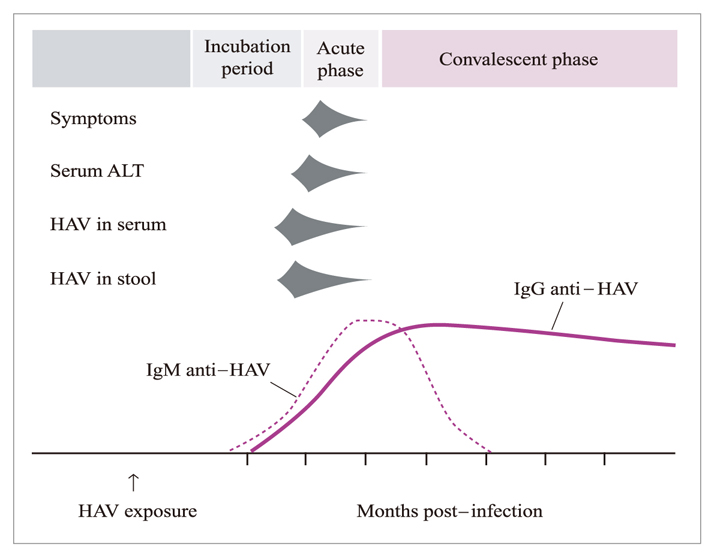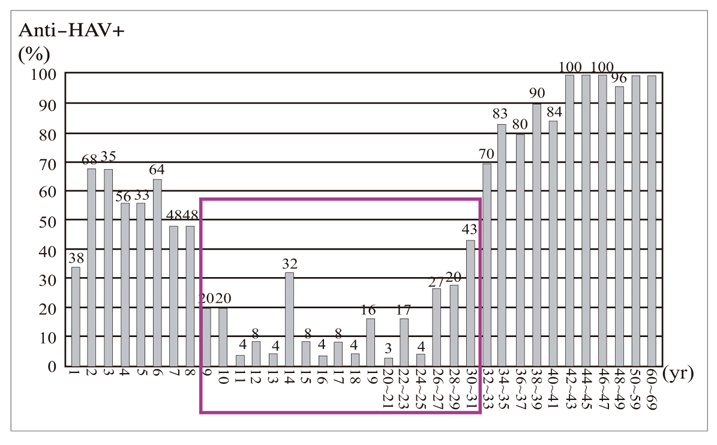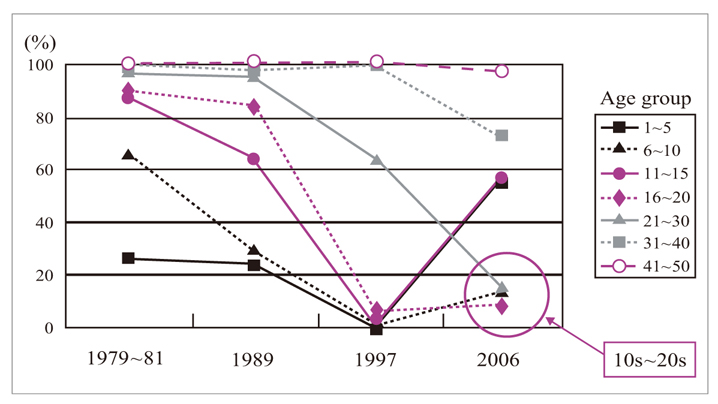Recent Epidemiological Status and Vaccination of Hepatitis A in Korea
- Affiliations
-
- 1Department of Childhood and Adolescent Medicine, The Catholic University of Korea College of Medicine, Korea. jh00mn@catholic.ac.kr
- KMID: 2185728
- DOI: http://doi.org/10.5124/jkma.2008.51.2.110
Abstract
- Hepatitis A is a vaccine preventable disease. Improvement in the socio-economic status and general public health of Korea over the last 30 years has led to a shift in the seroprevalence of hepatitis A. This lowered endemicity has caused an upward shift in the average age of infection, resulting in a larger number of individuals at risk of clinically significant hepatitis A infection. Now in Korea, for those aged less than 10 years old, the anti-HAV prevalence was above 50%, which is mainly contributed to the result of vaccination. However, the prevalences of antibody in the 10s and 20s were 10 to 30%, respectively, which are significantly lower than those in other age groups. As people in this age group are at high risk for an epidemic of hepatitis A, a catch-up immunization may be considered. Also, routine immunization should be considered in the near future after cost-effectiveness studies to control the disease burden of hepatitis A.
Keyword
MeSH Terms
Figure
Cited by 8 articles
-
국내 일개 대학 병원 근무 의료인의 A형간염항체 양성률에 대한 연구
Seul Ki Ji, So Hee Jang, Min Hee Park, Ji Eun Lee, Hye Sook Jeong, Joonhong Park, Seung Beom Han, Yunmi Yi, Sun Hee Park
Korean J Healthc Assoc Infect Control Prev. 2020;25(1):54-59. doi: 10.14192/kjicp.2020.25.1.54.Hepatitis A
Ky Young Cho
Korean J Pediatr Gastroenterol Nutr. 2010;13(Suppl 1):S70-S77. doi: 10.5223/kjpgn.2010.13.Suppl1.S70.Abnormality on Liver Function Test
Ki-Soo Kang
Pediatr Gastroenterol Hepatol Nutr. 2013;16(4):225-232. doi: 10.5223/pghn.2013.16.4.225.Hepatitis A: Past and Present
Sang Hoon Park
J Korean Med Assoc. 2009;52(10):996-1004. doi: 10.5124/jkma.2009.52.10.996.The Seroprevalence Rate, Vaccination Rate and Seroconversion Rate of Hepatitis A in Central Region of Korea
Seung Wook Yun, Won Kyung Lee, Sun Young Cho, Sung Hoon Moon, Hyun Deok Shin, Se Young Yun, Suk Bae Kim, Jeong Eun Shin, Hong Ja Kim, Il Han Song, Kun Song Lee, Jae Hyun Lee
Korean J Gastroenterol. 2011;57(3):166-172. doi: 10.4166/kjg.2011.57.3.166.Hepatitis A Virus Vaccination Status and Related Factors among College Students
Jae Seong Baek, Mi Ah Han, Jong Park, Na-Ra Yun
Korean J Health Promot. 2014;14(3):103-111. doi: 10.15384/kjhp.2014.14.3.103.An Epidemiological Analysis of Hepatitis A Virus Serologic Markers during the Recent Four Years in Korea
Anna Lee, Hyun-Sun Lim, Chung-Mo Nam, Sean-Mi Song, Hye-Ryoung Yoon, Kyoung-Ryul Lee
Korean J Lab Med. 2009;29(6):563-569. doi: 10.3343/kjlm.2009.29.6.563.Factors associated with Hepatitis A Preventative Behaviors among University Students
Jeong-Sil Choi, Ji Woon Ko, Seungmi Park
Korean J Adult Nurs. 2015;27(2):127-134. doi: 10.7469/kjan.2015.27.2.127.
Reference
-
1. American Academy of Pediatrics. Pickering LK, Baker CJ, Long SS, McMillan JA, editors. Hepatitis A. Red Book: 2006 Report of the Committee on Infectious Diseases. 2006. 27th ed. Elk Grove Village, IL: American Academy of Pediatrics;326–335.2. Kim H, Kim JH, Kim DU, Hur JK, Lee WB, Seo BK, Kang JH. Epidemiological changes and clinical features of hepatitis A in children, living in Kyunggi Province, since 1988 to 1998. Korean J Pediatr Infect Dis. 1998. 5:230–238.
Article3. Communicable Diseases Sentinel Surveillance: Viral Hepatitis Statistics. Korea Center for Disease Control and Prevention Communicable disease information system. Accessed on February 1st, 2007. at http://sentinel.cdc.go.kr/hepatitis/.4. Jacobsen KH, Koopman JS. Declining hepatitis A seroprevalence: a global review and analysis. Epidemiol Infect. 2004. 132:1005–1022.
Article5. Hollinger FB, Ticehurst JR. Fields BN, Knipe DM, Howley PM, editors. Hepatitis A virus. Fields Virology. 1996. 3rd ed. Philadelphia: Lippincott-Raven;735–782.6. Bell BP, Feinstone SM. Plokin SA, Orenstein WA, editors. Hepatitis A. Vaccine. 2004. 4th ed. Philadelphia: WB Saunders;269–297.7. Atkinson W, Hamborsky J, Mclntyre L, Wolfe C. Epidemiology and Prevention of Vaccine-Preventable Diseases. 2007. 10th ed. Atlanta, GA: Center for Disease Control and Prevention;197–210.8. Desenclos JC, Klontz KC, Wilder MH, Nainan OV, Margolis HS, Gunn RA. A multistate outbreak of hepatitis A caused by the consumption of raw oysters. Am J Public Health. 1991. 81:1268–1272.
Article9. Niu MT, Polish LB, Robertson BH, Khanna BK, Woodruff BA, Shapiro CN, Miller MA, Smith JD, Gedrose JK, Alter MJ, Margolis HS. Multistate outbreak of hepatitis A associated with frozen strawberries. J Infect Dis. 1992. 166:518–524.
Article10. Fiore AE. Hepatitis A transmitted by food. Clin Infect Dis. 2004. 38:705–715.
Article11. Wheeler C, Vogt TM, Armstrong GL, Vaughan G, Weltman A, Nainan OV, Dato V, Xia G, Waller K, Amon J, Lee TM, Highbaugh-Battle A, Hembree C, Evenson S, Ruta MA, Williams IT, Fiore AE, Bell BP. An outbreak of hepatitis A associated with green onions. N Engl J Med. 2005. 353:890–897.
Article12. Schuster CJ, Ellis AG, Robertson WJ, Charron DF, Aramini JJ, Marshall BJ, Medeiros DT. Infectious disease outbreaks related to drinking water in Canada, 1974~2001. Can J Public Health. 2005. 96:254–258.
Article13. Frank C, Walter J, Muehlen M, Jansen A, van Treeck U, Hauri AM, Zoellner I, Rakha M, Hoehne M, Hamouda O, Schreier E, Stark K. Major outbreak of hepatitis A associated with orange juice among tourists, Egypt, 2004. Emerg Infect Dis. 2007. 13:156–158.
Article14. Kedda MA, Kew MC, Cohn RJ, Field SP, Schwyzer R, Song E, Fernandes-Costa F. An outbreak of hepatitis A among South African patients with hemophilia: evidence implicating contaminated factor VIII concentrate as the source. Hepatology. 1995. 22:1363–1367.
Article15. Chudy M, Budek I, Keller-Stanislawski B, McCaustland KA, Neidhold S, Robertson BH, Nubling CM, Seitz R, Lower J. A new cluster of hepatitis A infection in hemophiliacs traced to a contaminated plasma pool. J Med Virol. 1999. 57:91–99.
Article16. Jee YM, Go U, Cheon D, Kang Y, Yoon JD, Lee SW, Shin YH, Kim KS, Lee JK, Jeong EK, Yang BK, Cho HW. Detection of hepatitis A virus from clotting factors implicated as a source of HAV infection among haemophilia patients in Korea. Epidemiol Infect. 2006. 134:87–93.
Article17. Choi JO, Lee KY, Lee DJ, Han JW, Hwang SS, Lee KS. Outbreak of hepatitis A in TaeJon in 1996: clinical and epidemiologic study in children. Korean J Pediatr Infect Dis. 1997. 4:90–96.
Article18. Lee TH, Kim SM, Lee GS, Im EH, Huh KC, Choi YW, Kang YW. Clinical features of acute hepatitis A in the Western part of Daejeon and Chungnam province: single center experience. Korean J Gastroenterol. 2006. 47:136–143.19. Lee BC, Lee DB. Clinical observation of type A hepatitis in children. J Korean Pediatr Soc. 1979. 22:213–221.20. Jung KM, Yeon JE, Bak YT, Kim JH, Kwon SY, Beon KS, Lee CH. Epidemiological study of acute hepatitis A in Seoul [Abstract]. Korean J Gastroenterol. 1995. 27:117.21. Lee CH, Chung KW, Moon YM, Yoo JY, Suh DJ, Lee SG. An outbreak of hepatitis A in Korean young adults in 1998 [Abstract]. Korean J Gastroenterol. 1998. 32(S1):105A.22. Kim JH, Kang JH, Seo K, Kim HM, Choi JY. A survey for seroprevalence of antibody to hepatitis A and development of policy. 2006. Seoul: Korea Centers for Disease Control and Prevention;1–41.23. Hong WS, Kim JY. Seroepidemiology of type A and type B hepatitis in Seoul area. J Korean Soc Intern Med. 1982. 25:19–26.24. Lim DS, Cho KH, Kim HC. Seroepidemiological study on anti-HAV antibody in Cheon-Buk Province in 1989. J Korean Soc Intern Med. 1992. 43:57–65.25. Sohn YM, Rho HO, Park MS, Park JH, Choi BY, Ki M, Jang WI. The changing epidemiology of hepatitis A in children and the consideration of active immunization in Korea. Yonsei Med J. 2000. 41:34–39.
Article26. Kang JH, Lee KY, Kim CH, Sim D. Changing hepatitis A epidemiology and the need for vaccination in Korea. Asian Pacific J Allergy Immunol. 2004. 22:237–242.27. The Division of Vaccine Preventable Disease Control and National Immunization Programme. Epidemiology and management of vaccine preventable diseases. 2006. Seoul: Korea Center for Disease Control and Prevention;341–351.28. Center for Disease Control and Prevention. Prevention of hepatitis A through active or passive immunization: recommendations of the Advisory Committee on Immunization Practices (ACIP). MMWR. 2006. 55(RR7):1–23.29. Van Damme P, Banatvala J, Fay O, Iwarson S, McMahon B, Van Herck K, Shouval D, Bonanni P, Connor B, Cooksley G, Leroux-Roels G, Von Sonnenburg F. International Consensus Group on Hepatitis A Virus Immunity. Hepatitis A booster vaccination: is there a need? Lancet. 2003. 362:1065–1071.
Article30. Werzberger A, Mensch B, Nalin DR, Kuter BJ. Effectiveness of hepatitis A vaccine in a former frequently affected community: 9 years' followup after the Monroe field trial of VAQTA. Vaccine. 2002. 20:1699–1701.
Article31. Halliday ML, Kang LY, Zhou TK, Hu MD, Pan QC, Fu TY, Huang YS, Hu SL. An epidemic of hepatitis A attributable to the ingestion of raw clams in Shanghai, China. J Infect Dis. 1991. 164:852–859.
Article32. Kang CI, Choi CM, Park TS, Lee DJ, Oh MD, Choe KW. Incidence and seroprevalence of hepatitis A virus infections among young Korean soldiers. J Korean Med Sci. 2007. 22:546–548.
Article33. Song HJ, Kim TH, Song JH, Oh HJ, Ryu KH, Yeom HJ, Kim SE, Jung HK, Shim KN, Jung SA, Yoo K, Moon IH, Chung KW. Emerging need for vaccination against hepatitis A virus in patients with chronic liver disease in Korea. J Korean Med Sci. 2007. 22:218–222.
Article
- Full Text Links
- Actions
-
Cited
- CITED
-
- Close
- Share
- Similar articles
-
- Prevention of Viral Hepatitis and Vaccination
- Current Status and Vaccine Indication for Hepatitis A Virus Infection in Korea
- Hepatitis B Vaccination Coverage and Related Factors among Aged 19 or Older in Republic of Korea
- The Effect of Hepatitis B Vaccination on Newborns of Hepatitis B Carrier Mothers
- A comparative study on the efficacy of low-dose intradermal hepatitis B vaccination






